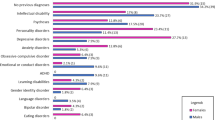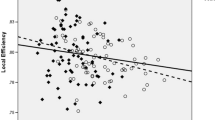Abstract
Autism spectrum disorder (ASD) is a condition that includes a number of neurodevelopmental mental disorders. Recent genetic/genomic investigations have reported an increased prevalence of copy number variations (CNVs) in individuals with autism. Despite the extensive evidence of a genetic component, the genes involved are not known and the background is heterogeneous among subjects. As such, it is highly likely that multiple events (molecular cascades) are implicated in the development of autism. The aim of this work was to shed some light on the biological background behind this condition. We hypothesized that the heterogeneous alterations found within different individuals may converge into one or more specific biological functions (pathways) linked to the heterogeneous phenotypes commonly observed in subjects with ASD. We analyzed a sample of 107 individuals for CNV alterations and checked the genes located within the altered loci (1366). Then, we characterized the subjects for distinct phenotypes. After creating subsamples based on symptoms, the CNVs related to each specific symptom were used to create distinct networks associated with each phenotype (18 in total in the sample under analysis). These networks were independently clustered and enriched to identify potential common pathways involved in autism and variably combined with the clinical phenotype. The first 10 pathways of the analysis are discussed.




Similar content being viewed by others
References
Adhya D et al. (2020) Atypical Neurogenesis in Induced Pluripotent Stem Cells From Autistic Individuals. Biol Psychiatry
Al-Ayadhi LY (2012) Relationship between Sonic hedgehog protein, brain-derived neurotrophic factor and oxidative stress in autism spectrum disorders. Neurochem Res 37(2):394–400
Alvarez-Buylla A, Ihrie RA (2014) Sonic hedgehog signaling in the postnatal brain. Semin Cell Dev Biol 33:105–111
Andrews DS et al. (2017) In Vivo Evidence of Reduced Integrity of the Gray-White Matter Boundary in Autism Spectrum Disorder. Cereb Cortex 27(2): 877–887
Baird G, Simonoff E, Pickles A, Chandler S, Loucas T, Meldrum D, Charman T (2006) Prevalence of disorders of the autism spectrum in a population cohort of children in South Thames: the Special Needs and Autism Project (SNAP). Lancet 368(9531):210–215
Basu SN, Kollu R, Banerjee-Basu S (2009) AutDB: a gene reference resource for autism research. Nucleic Acids Res, 2009. 37(Database issue): D832–836.
Bindea G, Mlecnik B, Hackl H, Charoentong P, Tosolini M, Kirilovsky A, Fridman WH, Pages F, Trajanoski Z, Galon J (2009) ClueGO: a Cytoscape plug-in to decipher functionally grouped gene ontology and pathway annotation networks. Bioinformatics 25(8):1091–1093
Bredesen DE, Mehlen P, Rabizadeh S (2004) Apoptosis and dependence receptors: a molecular basis for cellular addiction. Physiol Rev 84(2):411–430
Boyle EA, Li YI, Pritchard JK (2017) An Expanded View of Complex Traits: From Polygenic to Omnigenic. Cell 169(7):1177–1186
Choy SW, Cheng SH (2012) Hedgehog signaling. Vitam Horm 88:1–23
Cortese S, Wang F, Angriman M, Masi G, Bruni O (2020) Sleep Disorders in Children and Adolescents with Autism Spectrum Disorder: Diagnosis, Epidemiology, and Management. CNS Drugs 34(4):415–423
Cunningham CL, Martinez-Cerdeno V, Noctor SC (2013) Microglia regulate the number of neural precursor cells in the developing cerebral cortex. J Neurosci 33(10):4216–4233
De Rubeis S et. al. (2014) Synaptic, transcriptional and chromatin genes disrupted in autism. Nature 515(7526): 209–215
Donovan AP, Basson MA (2017) The neuroanatomy of autism - a developmental perspective. J Anat 230(1):4–15
Gaugler T, Klei L, Sanders SJ, Bodea CA, Goldberg AP, Lee AB, Mahajan M, Manaa D, Pawitan Y, Reichert J, Ripke S, Sandin S, Sklar P, Svantesson O, Reichenberg A, Hultman CM, Devlin B, Roeder K, Buxbaum JD (2014) Most genetic risk for autism resides with common variation. Nat Genet 46(8):881–885
Ghanizadeh A (2012) Malondialdehyde, Bcl-2, superoxide dismutase and glutathione peroxidase may mediate the association of sonic hedgehog protein and oxidative stress in autism. Neurochem Res 37(4):899–901
Goines PE, Ashwood P (2013) Cytokine dysregulation in autism spectrum disorders (ASD): possible role of the environment. Neurotoxicol Teratol 36:67–81
Goines P, Haapanen L, Boyce R, Duncanson P, Braunschweig D, Delwiche L, Hansen R, Hertz-Picciotto I, Ashwood P, Van de Water J (2011) Autoantibodies to cerebellum in children with autism associate with behavior. Brain Behav Immun 25(3):514–523
Grove J et al. (2019) Identification of common genetic risk variants for autism spectrum disorder. Nat Genet 51(3): 431–444
Halepoto DM, Bashir S, Zeina R, Al-Ayadhi LY (2015) Correlation Between Hedgehog (Hh) Protein Family and Brain-Derived Neurotrophic Factor (BDNF) in Autism Spectrum Disorder (ASD). J Coll Physicians Surg Pak 25(12):882–885
Hu VW, Sarachana T, Kim KS, Nguyen A, Kulkarni S, Steinberg ME, Luu T, Lai Y, Lee NH (2009) Gene expression profiling differentiates autism case-controls and phenotypic variants of autism spectrum disorders: evidence for circadian rhythm dysfunction in severe autism. Autism Res 2(2):78–97
Jarskog LF, Glantz LA, Gilmore JH, Lieberman JA (2005) Apoptotic mechanisms in the pathophysiology of schizophrenia. Prog Neuropsychopharmacol Biol Psychiatry 29(5):846–858
Kirschen GW, Xiong Q (2017) Primary cilia as a novel horizon between neuron and environment. Neural Regen Res 12(8):1225–1230
Lord C, Elsabbagh M, Baird G, Veenstra-Vanderweele J (2018) Autism spectrum disorder. Lancet 392(10146):508–520
Mamidipudi V, Cartwright CA (2009) A novel pro-apoptotic function of RACK1: suppression of Src activity in the intrinsic and Akt pathways. Oncogene 28(50):4421–4433
Mandy WP, Charman T, Skuse DH (2012) Testing the construct validity of proposed criteria for DSM-5 autism spectrum disorder. J Am Acad Child Adolesc Psychiatry 51(1):41–50
Marchetto MC, Belinson H, Tian Y, Freitas BC, Fu C, Vadodaria K, Beltrao-Braga P, Trujillo CA, Mendes APD, Padmanabhan K, Nunez Y, Ou J, Ghosh H, Wright R, Brennand K, Pierce K, Eichenfield L, Pramparo T, Eyler L, Barnes CC, Courchesne E, Geschwind DH, Gage FH, Wynshaw-Boris A, Muotri AR (2017) Altered proliferation and networks in neural cells derived from idiopathic autistic individuals. Mol Psychiatry 22(6):820–835
Mason EF, Rathmell JC (2011) Cell metabolism: an essential link between cell growth and apoptosis. Biochim Biophys Acta 1813(4):645–654
Nicholas B, Rudrasingham V, Nash S, Kirov G, Owen MJ, Wimpory DC (2007) Association of Per1 and Npas2 with autistic disorder: support for the clock genes/social timing hypothesis. Mol Psychiatry 12(6):581–592
Onore C, Careaga M, Ashwood P (2012) The role of immune dysfunction in the pathophysiology of autism. Brain Behav Immun 26(3):383–392
Orlova KA, Crino PB (2010) The tuberous sclerosis complex. Ann N Y Acad Sci 1184:87–105
Par A (1992) The second half of our century and the future of hepatology. Orv Hetil 133(2):110–111
Patel SS, Tomar S, Sharma D, Mahindroo N, Udayabanu M (2017) Targeting sonic hedgehog signaling in neurological disorders. Neurosci Biobehav Rev 74(Pt A):76–97
Pinato L, Galina Spilla CS, Markus RP, da Silveira Cruz-Machado S (2019) Dysregulation of Circadian Rhythms in Autism Spectrum Disorders. Curr Pharm Des 25(41): 4379–4393
Psychiatric GCBDWG (2011) Large-scale genome-wide association analysis of bipolar disorder identifies a new susceptibility locus near ODZ4. Nat Genet 43 (10): 977-983
Reiner O, Karzbrun E, Kshirsagar A, Kaibuchi K (2016) Regulation of neuronal migration, an emerging topic in autism spectrum disorders. J Neurochem 136(3):440–456
Rosso SB, Inestrosa NC (2013) WNT signaling in neuronal maturation and synaptogenesis. Front Cell Neurosci 7:103
Rutter M (2015) Some of the complexities involved in gene-environment interplay. Int J Epidemiol 44(4):1128–1129
Sandin S, Lichtenstein P, Kuja-Halkola R, Hultman C, Larsson H, Reichenberg A (2017) The Heritability of Autism Spectrum Disorder. JAMA 318(12):1182–1184
Satterstrom FK et al. (2020) Large-Scale Exome Sequencing Study Implicates Both Developmental and Functional Changes in the Neurobiology of Autism. Cell 180(3): 568–584 e523
Sato W, Uono S (2019) The atypical social brain network in autism: advances in structural and functional MRI studies. Curr Opin Neurol 32(4):617–621
Schizophrenia Working Group of the Psychiatric Genomics Consortium (2014) Biological insights from 108 schizophrenia-associated genetic loci. Nature 511(7510): 421–427
Schulkin J (2007) Autism and the amygdala: an endocrine hypothesis. Brain Cogn 65(1):87–99
Schumann CM, Amaral DG (2006) Stereological analysis of amygdala neuron number in autism. J Neurosci 26(29):7674–7679
Sebat J, Lakshmi B, Malhotra D, Troge J, Lese-Martin C, Walsh T, Yamrom B, Yoon S, Krasnitz A, Kendall J, Leotta A, Pai D, Zhang R, Lee YH, Hicks J, Spence SJ, Lee AT, Puura K, Lehtimaki T, Ledbetter D, Gregersen PK, Bregman J, Sutcliffe JS, Jobanputra V, Chung W, Warburton D, King MC, Skuse D, Geschwind DH, Gilliam TC, Ye K, Wigler M (2007) Strong association of de novo copy number mutations with autism. Science 316(5823):445–449
Shannon P, Markiel A, Ozier O, Baliga NS, Wang JT, Ramage D, Amin N, Schwikowski B, Ideker T (2003) Cytoscape: a software environment for integrated models of biomolecular interaction networks. Genome Res 13(11):2498–2504
SIGU (2013) Guidelines for Cytogenetic diagnosis, 2013 20/05/2020]; Available from: https://www.sigu.net/show/attivita/5/1/citogenetica
Stahl EA et al. (2019) Genome-wide association study identifies 30 loci associated with bipolar disorder. Nat Genet 51(5): 793–803
Tager-Flusberg H (2010) The origins of social impairments in autism spectrum disorder: studies of infants at risk. Neural Netw 23(8–9):1072–1076
Tick B, Bolton P, Happe F, Rutter M, Rijsdijk F (2016) Heritability of autism spectrum disorders: a meta-analysis of twin studies. J Child Psychol Psychiatry 57(5):585–595
Varga EA, Pastore M, Prior T, Herman GE, McBride KL (2009) The prevalence of PTEN mutations in a clinical pediatric cohort with autism spectrum disorders, developmental delay, and macrocephaly. Genet Med 11(2):111–117
Velinov M (2019) Genomic Copy Number Variations in the Autism Clinic—Work in Progress. Front Cell Neurosci 13(57)
Wei H, Alberts I, Li X (2014) The apoptotic perspective of autism. Int J Dev Neurosci 36:13–18
Zhang J, Fang Z, Jud C, Vansteensel MJ, Kaasik K, Lee CC, Albrecht U, Tamanini F, Meijer JH, Oostra BA, Nelson DL (2008) Fragile X-related proteins regulate mammalian circadian behavioral rhythms. Am J Hum Genet 83(1):43–52
Author information
Authors and Affiliations
Corresponding author
Additional information
Publisher’s Note
Springer Nature remains neutral with regard to jurisdictional claims in published maps and institutional affiliations.
Supplementary Information
Below is the link to the electronic supplementary material.
Rights and permissions
About this article
Cite this article
Briuglia, S., Calabrò, M., Capra, A.P. et al. Molecular Pathways within Autism Spectrum Disorder Endophenotypes. J Mol Neurosci 71, 1357–1367 (2021). https://doi.org/10.1007/s12031-020-01782-7
Received:
Accepted:
Published:
Issue Date:
DOI: https://doi.org/10.1007/s12031-020-01782-7




